
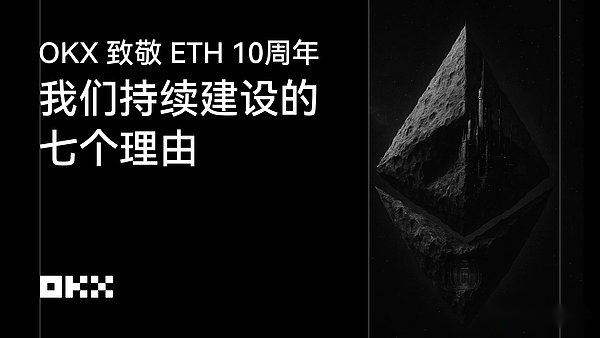
On July 30, 2025, the world ushered in an important moment in the 10th anniversary of the founding of Ethereum.Ethereum, a community-driven and open source governance blockchain platform, continues to lead the evolution of technology and application expansion, and has developed from the pioneer of smart contracts to the core foundation of the entire Web3 ecosystem. It not only triggers systemic changes in financial innovation, asset programmability and data sovereignty, but also continues to make breakthroughs in the fields of scalability, privacy computing and cross-chain interoperability, becoming a dominant infrastructure.
Currently, Ethereum carries more than 50% of the world’s non-bitcoin digital assets, including about 60% of the total stablecoin issuance, more than 60% of the decentralized finance (DeFi) locked capital, and up to 80% of the real-world assets (RWA) on-chain mapping, such as stocks, money market funds and bonds.This achievement consolidates Ethereum’s backbone position in the global digital economy and Web3 ecosystem.
Over the past decade, we have unswervingly built the Ethereum ecosystem.Behind this, there are seven reasons we always stick to.
1. Leading developer ecosystem
1.1 Rich developer ecosystem and growth trends
○ The Ethereum main network was launched in 2015, with about 1,085 active developers.As of 2024, there were about 23,613 active developers worldwide, with an average annual compound growth rate of 39% over the past ten years; among which Ethereum has always maintained its largest developer community status.
○ In 2024, about 16,700 new developers contributed code to the Ethereum ecosystem, three times that of Polygon and nearly four times that of Solana.Despite the impact of the bear market in recent years, the number of active developers in Web in March has slightly decreased from its peak (about 7% year-on-year), the number of “old developers” with more than two years of experience has increased by 27%, stably supporting ecological innovation.
○ Senior developers (code contributions over two years) account for more than 70% of the overall, becoming the cornerstone of the continuous innovation of the Ethereum ecosystem.

1.2 Continuous expansion of EVM ecosystem and network effects
○ Currently, one-third of the world’s crypto developers are multi-chain developers, and 34% are active in more than two public chains at the same time every month, a significant increase from 2015 (<10%).
○ The ecological aggregation effect of Ethereum Virtual Machine (EVM) is obvious: 74% of multi-chain developers have made active contributions to the EVM chain, and EVM cross-chain deployers have increased by 4 times since 2021.
○ EVM compatible chains such as Base, Polygon, Starknet attract a large number of developers, share tool chains and code bases, greatly lower the threshold for innovation, and enhance ecological stickiness.
○ The “code innovation” of the EVM ecosystem is moving to Layer 2 and new chains: in 2024, the main network and L2s jointly carried 65% of the innovative code, and Base once accounted for 25% of the EVM innovation logic.
○ In 2023, there will be 17 crypto ecosystems around the world, attracting more than a thousand active developers every month, of which EVM chains occupy the majority.
1.3 Ethereum (Solidity/EVM) has always been the public chain with the most developers and the richest ecosystem
○ Solana (Rust) developers grew rapidly, and the number of new developers exceeded Ethereum for the first time in 2024, but the total developer scale is not as good as Ethereum.
○ The Move ecosystem represented by Aptos and Sui is still far lower than that of EVM and Rust chains, but the growth rate is obvious, focusing on asset security, resource orientation, and talent aggregation.
○ Ethereum has set open standards and benchmarks for development tools for the blockchain industry, from code frameworks (such as Hardhat, Foundry, OpenZeppelin) to infrastructures (such as L2 Rollup, NFT protocol), effectively reducing the entry threshold and learning costs of global developers.
2. A ecology of continuous growth and innovation expansion
2.1 Ecological evolution and innovation leadership
○ In 2015, the Ethereum main network was launched, opening a new era of smart contracts and decentralized applications (dApps).In the past decade, Ethereum has driven multiple rounds of innovation such as DeFi, NFT, RWA (real world assets), becoming a global blockchain application infrastructure and innovation highland.
○ Ethereum Rollup expansion (such as Optimism, Arbitrum, zkSync), sharding, state pricing mechanism innovation (Pectra, etc. upgrade) has significantly improved network throughput and user experience.
○ The application scenarios have expanded from DeFi, NFT, etc. to RWA, AI on-chain, social networking, GameFi, etc., greatly enriching the on-chain ecology and cross-border innovation.
2.2 Full view of ecological innovation data and on-chain indicators
○ Changes in total locked volume (TVL)
▪ In 2025, DeFi TVL reached approximately $62.59B, a year-on-year increase of 30%, accounting for more than 53% of the global DeFi ecosystem. The leading agreements include Lido, Aave, EigenLayer, Etherfi, and Sky.The market expects Ethereum TVL to exceed $100B by the end of 2025.
▪ Rollup and other Layer 2 TVL continues to increase, and the EVM ecosystem leads multi-chain linkage.
○ Trading volume and activity
▪ Ethereum’s average daily trading volume (July 2025): 1,605,000 transactions, an increase of 44.6% over the same period last year, and the network activity reached a new high.
▪ The number of active wallets in 2025 has reached 127 million, an increase of 22% year-on-year. Multi-chain interoperability has strengthened the user base and developer base.
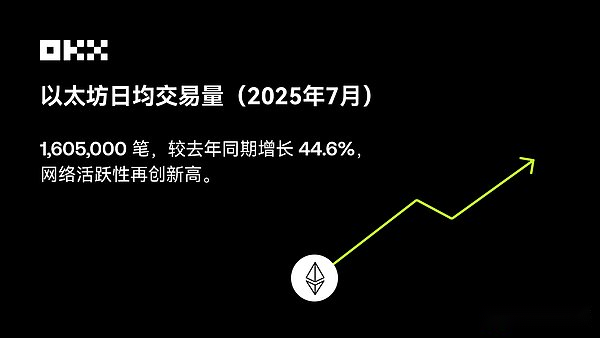
2.3 ETH leads the development of RWA ecology
○ In July 2025, the total scale of on-chain RWA reached $24.8B, and more than 54.9% of them were issued on the Ethereum main chain.
○ Assets and Holders: A total of 341 RWA assets were issued on Ethereum, with the number of asset holders being 81,388.
○ Stablecoin support: As the key infrastructure of RWA, the market value of stablecoins on Ethereum is approximately US$141.01 billion, accounting for 54.7% of the total market value of stablecoins.The number of stablecoin holders in the Ethereum network exceeds 14.74 million.
○ In Ethereum Layer 2, ZKsync Era RWA has a scale of US$2.334 billion, with 38 assets, accounting for 18.33% of the RWA market share.
○ Asset types cover US Treasury bonds, gold, money market funds, stocks, corporate bonds, etc. Leading projects include BlackRock BUIDL, Paxos Gold PAXG, Tether Gold XAUT, etc.Among them, the single asset scale of BUIDL exceeded $2.43 billion, and the PAXG exceeded $940 million.
○ There are 320,000 RWA asset holders and 255 institutions and service providers worldwide, and the new issuance speed of RWA has increased rapidly year-on-year.
3. Continuously improved performance and scalability
3.1 Review of technological upgrade progress
○ Since its birth in 2015, Ethereum has undergone multiple rounds of major technological evolution in performance and scalability, which has had a profound impact on the blockchain industry.
▪ 2017 Byzantium upgrade: Introducing a number of EVM optimizations, reducing mining rewards and laying the foundation for subsequent on-chain smart contract iterations.
▪ 2019 Istanbul, Constantinople: Improve transaction fee efficiency, enhance support for Layer2 and network attack resistance.
▪ 2020–2021 Beacon Chain & The Merge Preparation: Starting the transformation to Proof of Stake (PoS) with beacon chains has laid the foundation for an efficient and secure consensus mechanism.
▪ 2022 The Merge (Bellatrix/Paris/Shapella): The main network and beacon chain are merged to fully complete PoS conversion, reduce energy consumption by more than 99%, and clear obstacles for future scalability upgrades.
▪ 2024–2025 Dencun/Pectra upgrade: Technical advances represented by EIP-4844 (Proto-Danksharding) are introduced for the first time to introduce shard-related data structures, optimize data transmission bandwidth and greatly reduce L2 transaction costs.
▪ As of 2025, Ethereum has achieved the strategic goal of greatly reducing energy consumption, further improving security, and transferring idle loads from the main network to Layer2 through the above upgrades, providing a solid foundation for subsequent large-scale scalability.
3.2 Layer 2 Technology Progress and Data Evolution
• The successful expansion of the Ethereum ecosystem is inseparable from the explosive development of the Layer 2 network:
○ In July 2025, the peak TPS of the Ethereum Layer2 network (including Arbitrum, Optimism, Base, zkSync Era, etc.) hit a new high, with an average daily combined TPS exceeding 50, and millions of transactions were processed in a single day, surpassing the main network.
○ The mainstream L2 transaction fee is usually less than $0.10/transaction, which is much lower than the average main network $0.75/transaction.
• Leading the progress of Layer2 ecology and agreements
○ Arbitrum, Optimism, Base, zkSync Era, StarkNet, Polygon zkEVM, etc. have become the main gathering places for funds and users.
○ In 2025, Layer2 locked positions (TVL) continued to grow, with Arbitrum and Optimism having a total locked position of more than $10B. Base has emerged as a sudden move, and TPS alone once led the way, accounting for 40% of the transaction processing capacity of the entire ecosystem.
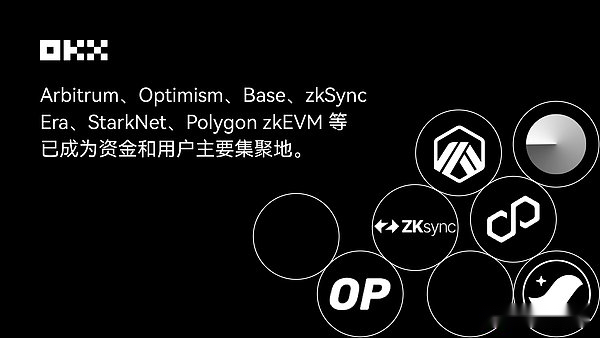
3.3 Technical Outlook
○ The Rollup dual-track pattern based on L1: In the future, the Ethereum ecosystem will evolve into two parallel Rollup models.One category is Based Rollup, which is deeply aligned with Ethereum. They use L1 for native sorting and verification, inherit their top-level security and trustworthiness neutrality, and mainly serve high-value DeFi, governance and asset custody scenarios.The other category is high-performance Rollup, which optimizes throughput and experience for large-scale user scenarios such as gaming and social networking, and usually adopts centralized sorting or alternative data availability (DA) solutions.This differentiation will lead to market integration, and the middle layer Rollup that lacks clear performance or safe alignment advantages will be marginalized.
○ Technical Leap of Layer 1: Ethereum L1 is shifting from “recent execution” to “light verification” zkEVM paradigm, improving its own performance and decentralization level through comprehensive architectural upgrades.
▪ The execution layer introduces RISC-V virtual machines to improve zero-knowledge proof efficiency and broaden the developer ecosystem.
▪ The settlement layer uses the EXECUTE precompilation function to realize native verification of Rollup and turn it into a protocol-level execution shard.
▪ The consensus layer is upgraded to Beam Chain, shortening the final certainty to about 12 seconds and reducing the validator threshold to 1 ETH, greatly enhancing network neutrality.
▪ The data availability layer uses Danksharding to improve throughput capabilities to the level that supports the ecosystem to achieve tens of millions of TPS.
○ The reconstructed L1 will become the undisputed global asset settlement layer.Its enhanced security and neutrality provide a solid foundation for Based Rollup to attract high-value applications and liquidity.The value generated by these Rollups, such as MEV and transaction fees, will flow back to the Ethereum main network, strengthening the economic model and security budget of ETH.This predictable and highly secure underlying protocol is key to winning institutional trust and promoting the adoption of real-world assets (RWA) and large-scale financial applications.
○ “Trustware”: The trust engine of the global economy.Ethereum is evolving into a “Trustware”, an infrastructure that will trust production industrialization.It replaces the expensive and inefficient legal, auditing and intermediary institutions in traditional finance through algorithms that generate the necessary effectiveness and finality of the digital world at extremely low marginal costs.In this way, Ethereum provides a scalable trust foundation for the digitization of global assets, capital and financial transactions, committed to becoming a global ledger that supports the digital economy in the future.
IV. Decentralization and security
4.1 The nodes are widely distributed
○ Globalization consensus and network effects
▪ In the past 10 years, ETH has formed a full global consensus through a network of nodes spread all over the world.ETH has deployed 8,665 nodes in 86 countries.
▪ The number of ETH nodes is still growing. The rise in ETH price and the increase in market expectations have directly inspired more users to participate in node operations. The number of nodes has increased by 8.06% in the past 7 days, which reflects the firm confidence of coin holders in the future development of ETH.
○ Bilateral recognition of China and the United States brings high mainstream consensus
▪ In the ETH node network, the United States and China dominate, ranking in the top two with 3,986 nodes (45.73%) and 2,154 nodes (24.71%) respectively. The two countries account for more than 70.44%, which fully demonstrates that ETH has received extremely high mental recognition among the two major economies of the East and the West.
▪ The developed infrastructure, mature developer ecosystem and high cryptocurrency adoption rate in the United States and China provide strong support for the stable operation of the ETH node network. The extensive deployment of ETH in the two countries not only enhances network security, but also lays a solid foundation for its further application in the global financial and technology fields.
○ Extensive decentralization and security
▪ The nodes of ETH are distributed in 6 continents: the number of nodes in Europe is second only to North America, including Germany, the United Kingdom, the Netherlands and other countries; although Asia strictly regulates cryptocurrencies, China, Japan and South Korea still operate a large number of nodes; South America, Oceania and Africa are growing rapidly, including Brazil, Argentina, Australia, New Zealand, South Africa, Nigeria and other countries, showing the strong potential of ETH in emerging markets.
▪ Although the United States and China have an absolute advantage in the proportion of the number of nodes, there are still more than 10 countries with more than 1% of the number of nodes, including Germany, Japan, France, the United Kingdom, Canada, Singapore, the Netherlands, etc.If the execution layer and the consensus layer are counted separately, their node distribution will be more discrete, which are the unbreakable cornerstones of ETH that are recognized as the most decentralized and secure public chains.
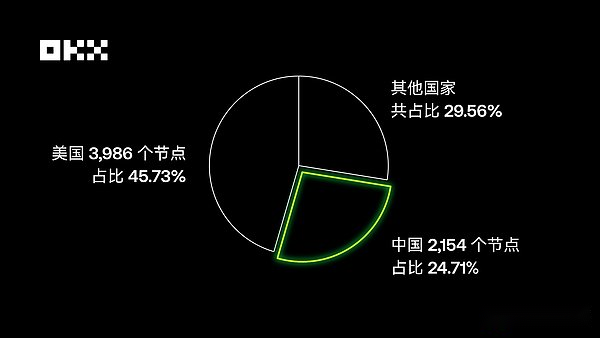
4.2 Diversity Client
○ Scale and diverse client
▪ There are currently 6 mainstream clients in the execution layer of ETH (excluding those with too small share), including Geth, Nethermind, Besu, Eragon, Reth and EthereumJS. There are a total of 15,018 clients running.These clients have their own characteristics and meet the needs of different users and developers.Geth is the most widely used client, directly maintained by the ETH Foundation; Nethermind and Besu focus more on enterprise-level applications, providing high performance and scalability; Erign and Reth focus on optimizing data storage and synchronization efficiency, providing developers with more efficient tools.
▪ In the consensus layer, ETH also supports 6 mainstream clients (excluding those with too small share), including Lighthouse, Lodestar, Nimbus, Teku, Prysm and Grandie, with a total of 8,850 clients running.They are implemented through different technologies, ensuring the diversity and security of the ETH consensus mechanism.For example, Lighthouse is known for its high performance and low resource consumption, suitable for individual node operators; Prysm has become the first choice for many organizations for its ease of use and rich functionality.
○ Fully support for multi-language and multi-system
▪ The ETH client performs excellent in technical compatibility and fully supports mainstream development languages, including Go, Java, Rust, etc.It not only reduces the learning costs of developers, but also attracts developers from different technical backgrounds to participate in the construction of the ETH ecosystem.Geth is suitable for developers who are familiar with Go; Nethermind is based on the .NET framework, providing convenience for C# developers; Reth and Lighthouse use the Rust language, attracting developers who focus on performance and security.
▪ The ETH client is fully compatible with mainstream operating systems such as Linux, Windows and MacOS, meeting different technical stack needs.This cross-platform compatibility not only improves the ease of use of the client, but also expands the user base of ETH.For example, individual developers can quickly build nodes in a Windows environment, while enterprise users can deploy high-performance clients on Linux servers.
▪ Strong compatibility has won ETH extensive community support.As the official client of the ETH Foundation, Geth has a huge developer community and rich document resources; Nethermind and Besu have promoted the implementation of ETH in enterprise-level applications through in-depth cooperation with enterprises.The diversity of clients not only ensures technological innovation and iteration, but also accelerates the development of the ETH technology ecosystem.
4.3 Restaking data
○ Restaking has a steady growth in scale and rich agreements
▪ ETH, as the source of the Restaking and Liquid Restaking narratives, its ecological scale continues to expand with the continued rise in ETH prices.ETH Restaking TVL has exceeded US$19.96 billion, accounting for 76% of the total ecosystem of US$26.41 billion, which is 4.9 times the second-ranked BTC ecosystem of US$5.42 billion. The continued rise in TVL not only improves capital utilization, but also enhances the security of the ETH network.
▪ ETH LST TVL has exceeded US$14.08 billion, accounting for 95% of the total ecosystem’s US$14.75 billion, which is 48.5 times the second-ranked Solana ecosystem’s US$290 million. By converting pledged assets into liquid tokens, it provides users with higher funding flexibility and attracts a large number of DeFi protocols to participate. ETH maintains an absolute advantage in this field.
▪ The ETH Restaking ecosystem is not only huge in scale, but also has nurtured multiple innovative protocols.EigenLayer and Symbiotic are the most representative, with TVLs of up to US$18.1 billion and US$1.54 billion respectively; LST agreements are more abundant, with TVL having more than US$100 million in 7 agreements and 3 agreements with more than US$1 billion, namely ether.fi of US$9.8 billion, Kelp of US$1.56 billion and Renzo of US$1.14 billion respectively. The number and diversity of agreements far exceed other ecosystems.
5. Official governance organization that constantly iterates itself
5.1 Continuous improvement of EF management
○ EF welcomes a new management team
▪ In March, EF announced the most significant leadership change in recent years: former executive director Aya Miyagotchi was transferred to the foundation’s chairman, Hsiao-Wei Wang and Tomasz Stańczak were appointed as co-executive directors, and fellow researcher Danny Ryan joined the new organization Etherealize.
▪ Aya Miyaguchi has served as the executive director of EF since 2018, leading ETH to accomplish many milestones.After this transfer as chairman, it is more responsible for promoting strategic cooperation and maintaining relationships, and will reduce direct participation in specific matters.The adjustment of the management team seven years later sent a clear signal of EF self-iteration to the outside world.
▪ The dual executive director structure of Hsiao-Wei Wang and Tomasz disperses decision-making responsibilities and reduces the risk of single points of failure. The two executive directors’ respective technical and management backgrounds have also formed a strong complementarity. This management update has also received congratulations and welcomes from the community and industry organizations.
○ The new management team brings clear directions and priorities
▪ Hsiao-Wei Wang emphasized that in the long run, they will promote the foundation’s work with “guiding principles” (core values) and “specific goals” (measurable influence and resilience).The four cornerstones of ETH – censorship resistance, open source innovation, privacy protection and security are still the underlying basis for all their decisions and actions.
▪ For the next year, they will clearly focus on three key points: expanding the scalability of ETH mainnet (L1), optimizing data blob processing and improving overall user experience (UX), and also mentioning specific implementation matters including institutional-level SDKs (integrated hosting interface, compliance review and Gas fee optimization module), enterprise wallets based on Noir zero-knowledge compiler, entry into the Asia-Pacific and European markets, and cooperation with Singapore Digital Port and Swiss Crypto Valley.
○ Three new organizations
▪EF has successively established three important organizations this year, focusing on technology, governance and institutional integration.
▪ The most popular Etherealize is the institutional-level marketing and product department of the ETH ecosystem. It aims to promote the adoption of ETH in traditional financial markets (such as Wall Street). While promoting ETH as a value storage asset and underlying technology platform to institutions, it builds financial products, connects the ETH ecosystem and institutional funds, and enhances the main network economic cycle.The establishment of Etherealize defines EF’s determination to promote institutions’ adoption and establishment of open finance.
▪ EF Silviculture Society is an advisory group composed of 15 non-foundation members. Its main function is to ensure that the development of the ETH ecosystem is in line with core values such as open source, privacy, security, and censorship resistance. It declares EF’s respect for senior developers and industry experts and its confidence in further optimizing the community governance structure.
Ethereum Foundation Research is positioned as the research center of EF. It consists of five teams: Applied Research Group (ARG), consensus research and development, cryptography, protocol security and RIG. It covers the five most important links in the future development path of ETH, providing basic guarantees for technological evolution.
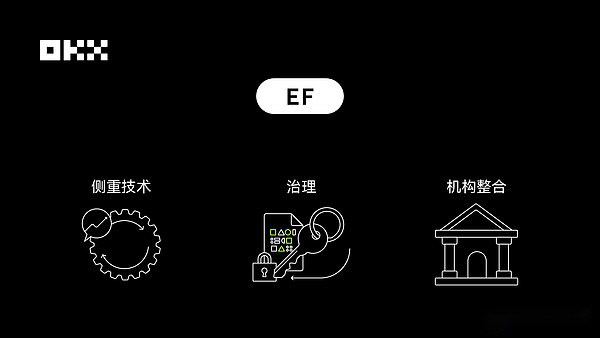
5.2 Advanced cluster community-based governance structure
○ EF always emphasizes that it is a non-profit organization and does not adopt a top-down corporate structure, but is more like a community cluster. The foundation supports many semi-autonomous teams that operate independently in their respective fields, while collaborating organically under the guidance of shared values.
○ The organizational structure of EF can be divided into four functional sectors: agreement research and development (PR&D), ecological development (EcoDev), operation guarantee (Ops) and privacy and expansion exploration (PSE). EF plays a bridge role in cross-team cooperation, but does not micro-manage each project, and encourages the team to “be self-centered and fulfill their responsibilities”. Such governance concepts and practices have always set an excellent benchmark for the entire industry.
5.3 The unchanging “Infinite Garden” vision
○ Guarding the “Infinite Garden”
▪ In April, Aya Miyaguchi and Vitalik Buterin jointly released an article titled “ETH Foundation Vision”, reiterating the mission, roles, high-quality matters and core principles of EF. They pointed out that the power of ETH should not only be reflected in the decentralized technical architecture, but should also be extended to widespread decentralization and autonomy at the organizational level.
▪ EF positiones itself as the guardian of the “Infinite Garden” and is by no means a centralized power node. Instead, it will be committed to guiding projects, communities and infrastructure in the ecosystem and enhancing the overall energy of the ecosystem. It must not only “complete what only EF can do today” (such as independent diversified clients and coordinate network upgrades), but also “help others do what only EF can do today” (such as funding public goods and localized communities).
▪ The focus of EF’s work is also very clear: First, maximize the number of ETH users and ensure that users can truly benefit from ETH’s censorship resistance, openness and privacy protection; second, improve the resilience of ETH technology and social infrastructure, and ensure that the ecosystem can operate independently and healthily even in extreme cases.
○ The future of ecosystem development
▪ On July 10, EF released its latest vision statement on the Future of Ecosystem Development, first clarifying the number of people who want to maximize the use of ETH directly or indirectly and benefit from its underlying values, and secondly, maximizing the resilience of ETH technology and social infrastructure. The specific path is to introduce four strategic pillars (acceleration, amplification, support and long-term clearance), establishing a new governance framework, and reforming its funding management strategy.
▪ In terms of ecological acceleration, EF has established a new support module for segmented directions, including: corporate relationships, developer growth, application support and founder support. Each module has a clear person in charge and detailed plan.
▪ In terms of funding reform, EF will also reduce the proportion of future operating expenses from 15% to 5% in 2025, gradually approaching the donor-oriented institutional standards, and conduct on-chain asset deployment to ensure long-term financial buffering.
6. Large-scale adoption of institutions
6.1 ETH ETF becomes a secondary rocket for institutional funding
○ETH ETFFrom no one to explosive growth
▪ In July 2024, the SEC officially approved the ETH spot ETF. In the early stages of approval, the total trading volume of the US ETH ETF once exceeded US$1 billion, showing strong market attention.However, as BTC was still in a price depression at that time, institutional funds were more inclined to raise BTC ETFs, resulting in the rapid decline in the trading volume of ETH ETFs to around US$200 million and continued until mid-2025.
▪ With the continued friendship of the regulatory framework, DeFi has integrated into traditional financial narratives, and ETH’s value carrying capacity has been completed and bottomed out again.Since May 2025, the total trading volume of ETH ETF has gradually rebounded to more than US$1 billion, with the highest turnover exceeding US$3 billion.
▪ The net inflow of ETH ETFs also showed strong growth momentum.In the past two months, ETH ETFs have achieved almost continuous net inflows (except for low net outflows in individual days), with a maximum daily net inflow of more than US$700 million.There is a highly fitted upward trend between ETH price, single-day net inflows and total net assets.
▪ As of now, the cumulative net inflow of ETH spot ETFs in the US market is US$8.89 billion and the total net asset value is US$20.48 billion, accounting for 16.2% of the cumulative net inflow of BTC spot ETFs in the US market of US$54.73 billion and 13.4% of the total net asset value of US$153.16 billion. The gap between the two is gradually narrowing.
○ The massive increase in institutional holdings has improved the ETH position structure
▪ Similar to BTC ETF, the issuers of ETH ETF also include major well-known asset management institutions around the world, including iShare, Grayscale, Fidelity, Franklin Templeton, VanEck and Invesco. There are currently 9 ETH ETFs, and the number of issuers is close to 12 of BTC ETFs.
▪ The active inflow of major ETFs has improved the holding structure of ETH. Institutional holdings accounted for 27% in 2025, nearly 2.5 times the 12% in 2024, and exchange circulation accounted for 18%, a significant decrease from 31% in 2024. This not only reflects the long-term optimism of institutions for ETH, but also provides stronger confidence for ordinary holders.
▪ At the same time, as the use of ETH networks recovers, its transaction fees are continuing to increase, effectively offsetting part of the inflation rate of ETH. The inflation rate of ETH has been significantly suppressed due to the PoS mechanism and the EIP-1559 destruction mechanism.As of July 2025, Ethereum’s inflation rate was at a low level.
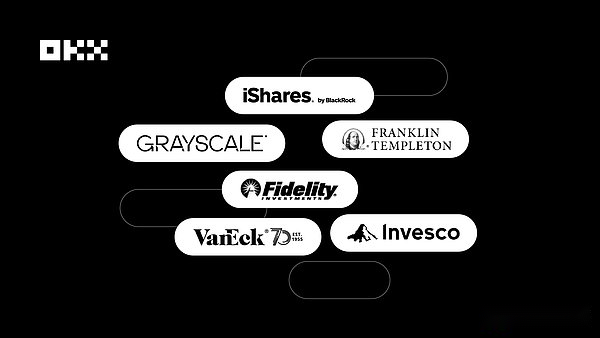
6.2 ETH becomes an important asset in the U.S. stock treasury
○ The ETH treasury strategy has been responded quickly by the US stock market
▪ As the BTC treasury strategy was the first to open up in the US stock market, ETH, as a high-quality asset, has also quickly found its own treasury strategy flywheel.Currently, ETH’s strategic reserves are 2.31 million, with a net value of US$8.56 billion, which is close to 40% of ETF holdings and net value.
▪ There are currently 63 companies that have officially established the ETH ETF treasury strategy. Compared with the 5 companies in April 2025, this strategy has gained a high degree of consensus among institutions in just 4 months.
▪ The two most representative companies, SharpLink Gaming and Bitmine Immersion Tech, reserved 360,000 and 560,000 ETH respectively, with market value of US$1.34 and 2.1 billion respectively, which has exceeded the 237,000 of the ETH Foundation; in addition, several institutions such as Bit Digital, BTCs, GameSqaure, and Coinbase hold tens of thousands of ETH.
○ More institutional holders will continue to raise the ETH consensus level
▪ The institutions that establish ETH treasury strategy have also shown a high degree of diversification, and heavyweight traders have entered the market one after another.Catherine Wood’s ARK Invest promotes ETH treasury by acquiring $182 million of BMNR common stock. SharpLink Gaming also received participation from Consensys, ParaFi Capital, Electric Capital, Pantera Capital, and Galaxy Digital in its private equity financing in May. Joseph Lubin, co-founder of ETH and founder and CEO of Consensys, served as chairman of the board of directors of SharpLink. Bitmine’s driving force behind the establishment of ETH strategic reserves is Thomas Lee, a well-known Wall Street strategist and Co-founder of Fundstrat.
▪ In addition to ETF institutions, US stock companies and Crypto companies, other types of institutions are also using ETH as the main asset type.Since its establishment in December 2024, the Trump family’s WLFI has held more than 70,000 ETH and is still continuing to purchase it.
▪ Joseph Lubin also stated in June that the company is building infrastructure with a sovereign wealth fund and bank in the ETH ecosystem.With the entry of diverse institutional holders, the consensus of ETH will become more three-dimensional and will be more extensive.
▪ Crypto Project Bank and Exchange are also actively increasing their holdings of ETH. In addition to the ETH Foundation, PulseChain holds 166,000 pieces, Golem Foundation holds 101,000 pieces, Gnosis DAO holds 66,000 pieces, and Coinbase holds 137,000 pieces.
▪ Referring to BTC’s growth path, we believe that the new round of value bottoming of ETH is still in progress.With the massive adoption of institutions, the value attributes of ETH will further differentiate from other altcoins and move closer to BTC.At the same time, ETH’s unique decentralization, security and on-chain economic ecosystem will continue to be coupled with traditional finance, further increasing the value capture capability of ETH. Therefore, we believe that ETH will have a better sustainability in rising.
7. Good cooperative relationship with OKX
7.1 OKX is a firm builder of the Ethereum ecosystem
○ OKX Wallet in ETH ETH Eco-data
▪ The earliest batch of wallets that support the Ethereum network and its ecosystem, and quickly respond to every official upgrade.
▪ In 2024, the daily call volume of Ethereum API provided by OKX Wallet has exceeded 900,000 times, covering core capabilities such as wallet management, smart contract interaction and on-chain data query.
▪In 2024, Justin Drake, a member of the Ethereum Foundation (hereinafter referred to as “EF”), had an in-depth conversation with Owen, the head of OKX Web3 product, to have in-depth exchanges on the technological improvement, consensus mechanism, scalability, security, DeFi, user experience, ecosystem, environmental impact, and future development and strategy of Ethereum 2.0.
▪ OKX Wallet co-sponsored three “Builder Experiences” exclusive events including ETHCCCannes 2025 Builder’s Club in July 2025, inviting more than 150 core project teams and ecological developers to participate, from technology sharing, hacker slogans to closed-door seminars, promoting Web3 innovation and cooperation in all aspects
▪ OKX is online, “ETH 50% off carnival” event. During the event, every time a user trades for every 1 ETH, he or she has the opportunity to win 0.5 ETH rewards. Each person participates up to 10 times, and 10 0.5 ETH prizes will be released every day. New users have a first transaction of USDT, and they can receive an annualized interest rate hike coupon of 26.08%; publish the event content and successfully invite 1 new user to trade, and can also receive a 100 USDT contract experience bonus.https://www.okx.com/zh-hans/campaigns/okx-eth-campaign?channelId=CNMEDIA
○ OKX Ventures invests in many core Ethereum tracks
▪ Infrastructure and expansion, such as: Arbitrum, ZKsync, Scroll, Taiko, StarkWare
▪ Decentralized pledge and re-staking, such as: SSV, ether.fi, Renzo
▪ AI and on-chain applications, such as: Myshell, Altlayer
▪ Cross-chain and data availability, such as Avail
▪In the future, OKX Ventures will continue to deepen its roots in the Ethereum ecosystem, capture the opportunities brought by technological iteration and emerging use cases, and help the industry develop in the long term.
In the past decade, Ethereum has been not only a public chain, but also a kind of power.It transforms the imaginative idea into real-life code, and directly returns the financial and contract scenarios that were required to be completed by layers of intermediaries to developers and users themselves.Every smart contract deployment and every decentralized finance transaction are proving that decentralized collaboration and transparent governance can support an open and inclusive digital world.Over the past decade, Ethereum has carried people’s desire for autonomy and equity, and has also witnessed how the community continues to strive for a common ideal.
On this road, OKX never watches. Through Wallet, it creates on-chain entrances, transaction aggregators, exploration, etc., so that users can easily experience its infinite possibilities; using investment and incubation, give those innovative projects the opportunity to grow.We are not passers-by, but builders who are walking along the way: at every critical moment of Ethereum, we are willing to contribute technology, resources and enthusiasm, accompany it to grow together, and welcome the further future.
Because builders are the most devout believers of Ethereum.
Disclaimer
This article is for reference only.This article only represents the author’s views.This article is not intended to provide (i) investment advice or investment recommendation; (ii) offer or solicitation for the purchase, sale or holding of digital assets; (iii) financial, accounting, legal or tax advice.We do not guarantee the accuracy, completeness or usefulness of such information.Digital assets held (including stablecoins and NFTs) are high-risk and may fluctuate significantly.You should carefully consider whether trading or holding digital assets is right for you based on your financial situation.For your specific situation, please consult your legal/tax/investment professional.Please be responsible for understanding and complying with relevant local applicable laws and regulations.








